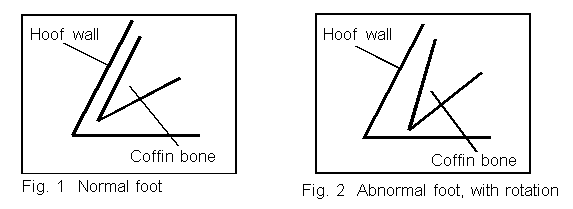
BUY THIS MANUAL NOW and have access to this article and 100's of others just like it!
View some of the 10+ Video clips found in the Equine Manual
Causes:
Laminitis can be caused by various environmental and disease processes. The following are just a few of the most common causes:* Ponies, mares, and overweight animals are at an increased risk.
* Each of these conditions causes inflammation and pressure within the hoof wall and constriction of the blood vessels, preventing adequate blood flow to the hoof. This constriction may be severe enough to cause permanent tissue damage and necrosis (death of the tissue).
Clinical Signs: The horse is often reluctant to move, or may move with very stiff front legs. The horse may go off feed and be lethargic. The animal will often shift weight back and forth from one leg to another, and be very sensitive to hoof testers over the toe area (see page B885). With experience and practice, the digital pulses of the feet can be felt and noted to be pounding in horses with laminitis (see page B150). The front legs are usually more involved than the hind; therefore, the animal may stand with the front legs forward and the hind legs tucked in underneath. In severe cases, the hoof may actually slough off, and/or the coffin bone of the foot can rotate downward into the bottom of the sole (see fig. 1 & 2 below). A horse with chronic laminitis will usually have thick rings in the hoof wall, parallel to the coronary band, and may have areas of hemorrhage or bleeding in the white line area.
Diagnosis: In many cases, laminitis can be diagnosed based on a physical exam and history. If this is not sufficient, a veterinarian can take a radiograph (X-ray) of the foot. The veterinarian can tell if there is any rotation of the coffin bone. See figures 1 and 2 below.
* See the anatomy portion of Section A for questions on anatomy.
Treatment: This involves four major areas.
- If grain overload is suspected, the horse should be given fluids, mineral oil, and Banamine. See page E285 for additional information.
- If an infection is suspected, treat the infection.
- Heavy horses should be placed on a weight loss program.
- Nonsteroidal anti-inflammatory drugs (NSAIDS) are essential (see bute and/or Banamine). Do not give corticosteroids, and be cautious regarding the duration and amounts of NSAIDS used.
Strict stall rest. (Duration depends on the severity of the rotation. See below under prognosis).
- This involves placing a frog support on the horse (Lilly pads or heart bar shoe).
- A roll of thick gauze over the frog, held in place by tape, can also provide the horse with frog support.
- Placing the horse in a sand covered or well bedded stall is critical. This allows the horse to rotate its feet to the position that is most comfortable.
- Ace, given 4 times a day, will help increase the circulation.
- Some researchers suggest walking a horse wearing frog support pads over soft ground for 5-10 minutes every 3-4 hours. Be careful not to overdo the exercise, since this may prolong the problem.
Prognosis: The prognosis will be determined by the animalís response to treatment and the degree of rotation of the coffin bone. See figures 1 and 2.
Prevention: Good management practices can prevent this problem much of the time. However, if any problem arises that may lead to potential laminitis, begin preventative measures immediately. Preventative measures may include NSAIDS, frog supports, and rest.
BUY THIS MANUAL NOW and have access to this article and 100's of others just like it!
View some of the 10+ Video clips found in the Equine Manual